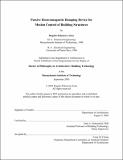Passive electromagnetic damping device for motion control of building structures
Author(s)
Palomera-Arias, Rogelio, 1972-
DownloadFull printable version (4.553Mb)
Other Contributors
Massachusetts Institute of Technology. Dept. of Architecture.
Advisor
John A. Ochsendorf.
Terms of use
Metadata
Show full item recordAbstract
The research presented in this thesis develops a new device for the passive control of motion in building structures: an electromagnetic damper. The electromagnetic damper is a self-excited device that provides a reaction force to an applied motion. We chose a tubular permanent-magnet linear machine as this new structural damper, and we derive its mathematical model using quasi-static electromagnetic theory. Computer simulations and experimental characterization of a small-scale prototype electromagnetic damper validated the mathematical model of the device. The behavior of the electromagnetic damper approximates that of an ideal damper. We conducted a feasibility study for the application of electromagnetic dampers to full-scale buildings. We used two performance measures: the damping density and the damping cost of the device. Comparing the performance of the electromagnetic damper to that of viscous fluid dampers, the maximum damping density of electromagnetic dampers is, at best, equal to that of hydraulic dampers, but with a price at least five times higher. The permanent magnet's current technology and cost are the limiting factors for the electromagnetic damper. (cont.) However, the electromagnetic damper provides flexibility not available previously to building designers as it can be used as a semi-active damper, as an actuator or as an energy regenerator without physical modifications to the device. Finally, we developed a design methodology for the electromagnetic damper to achieve a specified damping performance and introduced two techniques for the dynamic response analysis of buildings with electromagnetic dampers: One based on frequency domain approximations and one based on state-space models.
Description
Thesis (Ph. D.)--Massachusetts Institute of Technology, Dept. of Architecture, 2005. This electronic version was submitted by the student author. The certified thesis is available in the Institute Archives and Special Collections. Includes bibliographical references (leaves 112-115).
Date issued
2005Department
Massachusetts Institute of Technology. Department of ArchitecturePublisher
Massachusetts Institute of Technology
Keywords
Architecture.